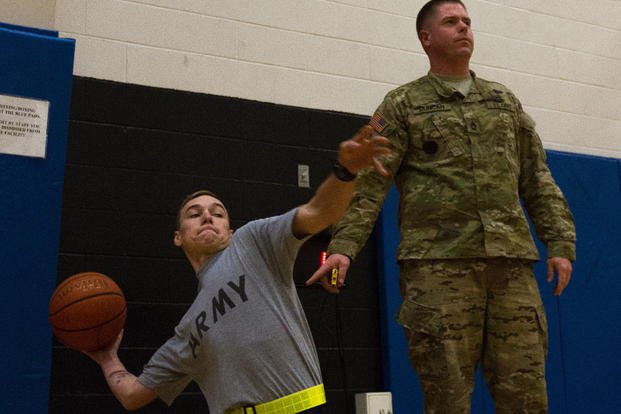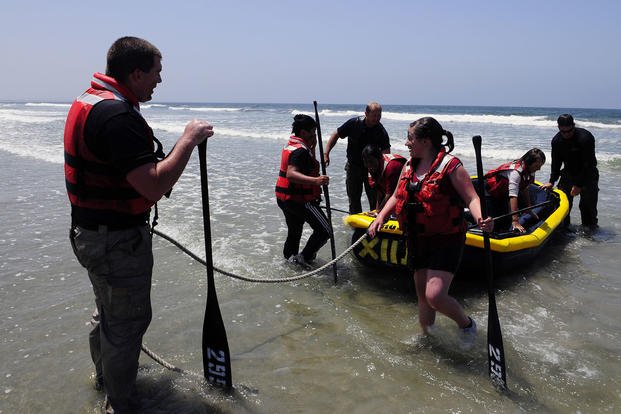Every year, I have the honor of working out with more than 2,000 high school students seeking acceptance into the Naval Academy during the Summer Seminar program. Hundreds of emails each year concerning all of the service academy programs have prompted me to write the most frequently asked questions I receive. These emails are from many of the young men and women seeking to serve their country.
Here they are:
1. Do All Services Have Their Own Academy? If So, How Do You Get into Them?
This is a monster of a question so I recommend thorough research on the websites of the academies below. All services have their own academy; however, the Naval Academy has around 15% of its class join the Marine Corps.
- Naval Academy, Annapolis, Md., USNA
- Air Force Academy, Colorado Springs, Colo., USAFA
- Military Academy, West Point, N.Y., USMA
- Coast Guard Academy, New London, Conn., USCGA
- Merchant Marine Academy, Kings Point, N.Y., USMMA
2. What Are the Physical Fitness Tests at the Academy?
They are all similar -- and some identical -- but here are the actual tests they take before and during the academy:
USNA, USAFA and USMA take the candidate fitness assessment (CFA):
- Basketball throw
- Push-ups
- Sit-ups
- Pull-ups
- One-mile run
USCGA, USMMA:
- Push-ups
- Sit-ups
- 1.5-mile run
All academies perform push-ups, sit-ups and a 1.5-mile run every six months while attending the four-year school. However, West Point (Army) does a two-mile run.

3. What Is Up with the Basketball Throw? Where Did They Get This Test?
Ha, good one. It is actually part of an older exam called the PAE (physical aptitude exam), which basically measures one's potential to be a strong candidate/athlete. The test demonstrates athletic ability to a degree and shoulder girdle and torso rotational power as well. It is a bit different from all other tests out there, but the Army, Navy and Air Force use it, so who am I to argue?
4. Can You Fail the CFA?
Well, since the academies are very competitive, it helps to have good to great scores in everything you can to set yourself apart from the other 10,000 to 12,000 or so applicants most academies receive. Notice there are no minimum standards. Striving for a minimum standard cannot be a part of your work ethic if you want to get into an academy -- and especially if you want to graduate.
5. On Average, What Are the Numbers Who Apply, Get Accepted and Graduate?
Using the Naval Academy as an example: In recent years, around 10,000-12,000 people apply, about 4,000 get nominations, and around 1,200-1,300 get accepted each year. Usually, graduating classes drop to less than 1,000 after four years. My class was 1,350, and we graduated a little more than 900.
6. How Do You Become a Marine at the Naval Academy?
As with any service selection opportunity, you will be given a course to follow through your four years there that can take you directly to the graduating ranks of the USMC. Usually, it requires a few summer training periods with Marine units; attending a summer program for midshipmen seeking USMC officer slots at Quantico, Virginia; taking the USMC PFT (pull-ups, sit-ups, three-mile run); and keeping up with your academics and leadership experience positions.

7. How Do You Become a SEAL from the USNA?
Very similar to the way you become a Marine. You should attend the Navy SEAL PTs, spend assigned duty at a SEAL team (internships) during leave time and score extremely well on your BUD/S physical screening test (PST):
- 500-yard swim: Sub-eight minutes (recommended competitive scores)
- Push-ups 100
- Sit-ups 100
- Pull-ups 25
- 1.5-mile run in boots/pants: Sub-nine minutes
You also will have to endure a 24- to 36-hour event called BUD/S screening, which is run by the SEAL instructors at USNA. It basically is all the bad events that occur during the six months of training at BUD/S, condensed into a 24- to 36-hour period. It's pretty tough, but that helps weed out the competition a bit.
The final event is a SEAL interview with a board of SEALs in charge of selecting all officers going to SEAL training. Very intimidating but relax, be yourself, show confidence but not arrogance, and you will be fine.
8. Can You Join the Military Even if You Go to the Merchant Marine Academy?
Yes. I know of several who have gone on to serve in the military. A few have become Navy SEALs, too.
9. Are the Service Academies "Real" Colleges?
Depends how you define real. Yes, they are accredited universities and actually very competitive with Ivy League schools with challenging curricula. Now will you have a "real" college experience? It's up to you. You get to leave on weekends and relax and have fun, but during the week, it is work -- work out, go to school, do a sport, eat, study and sleep.
10. Why Did You Choose the Naval Academy? Why a Service Academy?
I knew I wanted to be in the military at about age 16. I just did not know what I wanted to do. I figured if I can be in the military and go to college, that was even better so I looked into ROTC and service academies. After some pre-internet research, I noticed the Navy bases always were near a beach. Being from Florida, that seemed nice.
After pondering pilot or Navy SEAL, I eventually decided on Navy SEALs after meeting several on campus. Also, five guys on my rugby team became SEAL.s too. We were workout buddies, so it just seemed to fit.
For your best source of information, visit the academy websites and read their frequently asked questions pages.
Get the Insider's Guide to Joining the Military
Stew Smith is a former Navy SEAL and fitness author certified as a Strength and Conditioning Specialist (CSCS) with the National Strength and Conditioning Association. Visit his Fitness eBook store if you're looking to start a workout program to create a healthy lifestyle. Send your fitness questions to stew@stewsmith.com.
Want to Learn More About Military Life?
Whether you're thinking of joining the military, looking for fitness and basic training tips, or keeping up with military life and benefits, Military.com has you covered. Subscribe to Military.com to have military news, updates and resources delivered directly to your inbox.


















